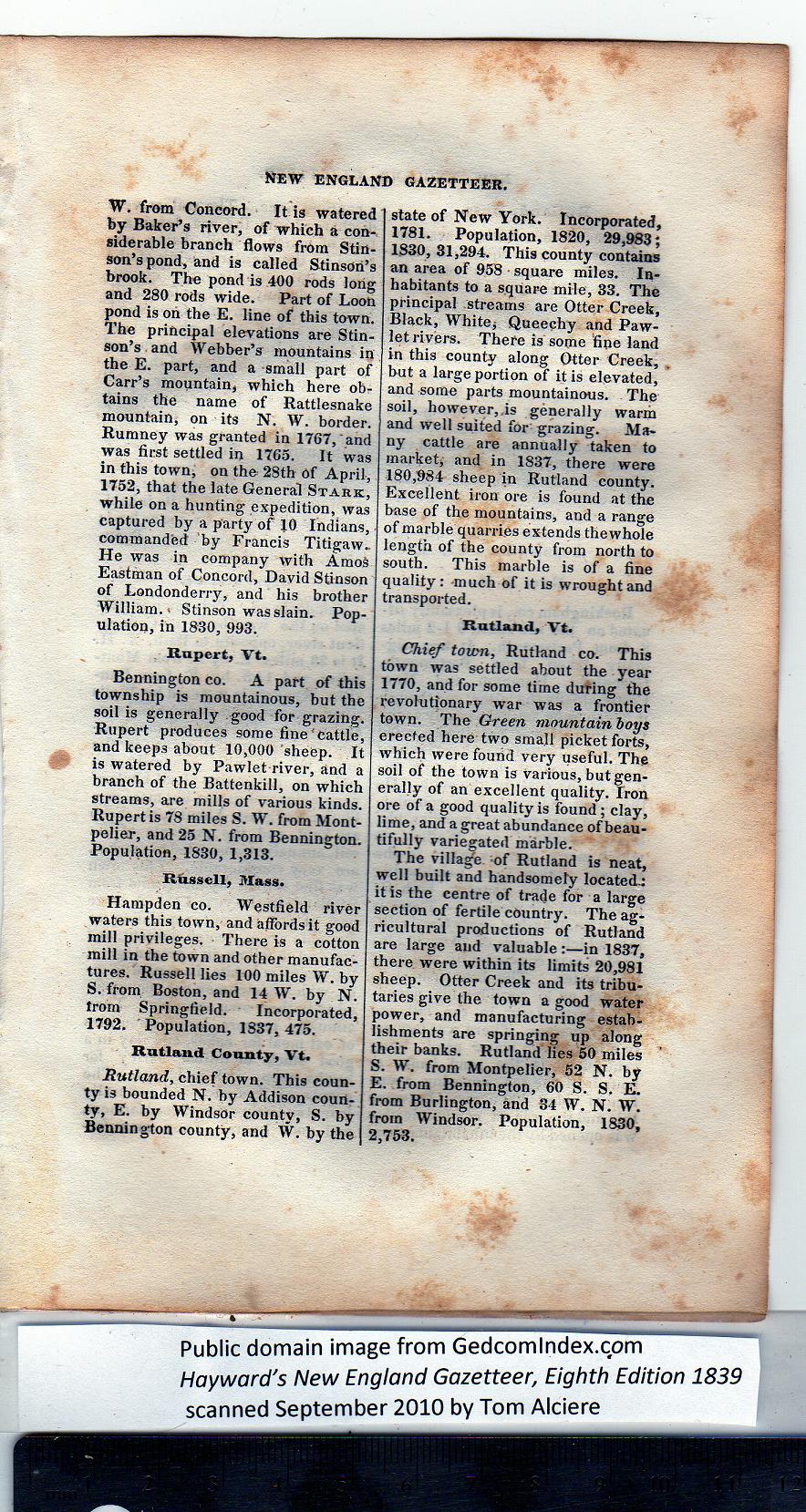|
W. from Concord. It is watered
by Baker’s river, of which a con-
siderable branch flows from Stin-
son’s pond, and is called Stinson’s
brook. The pond is 400 rods long
and 280 rods wide. Part of Loon
pond is on the E. line of this town.
The principal elevations are Stin-
son’s and Webber’s mountains in
the E. part, and a small part of
Carr’s mountain, which here ob-
tains the name of Rattlesnake
mountain, on its N. W. border.
Rumney was granted in 1767, and
was first settled in 1765. It was
in this town, on the 28th Of April,
1752, that the late General Stark,
while on a hunting expedition, was
captured by a party of 10 Indians,
commanded by Francis Titigaw.
He was in company with AmoS
Eastman of Concord, David Stinson
of Londonderry, and his brother
William. - Stinson was slain. Pop-
ulation, in 1830, 993.
Rupert, Vt.
Bennington co. A part of this
township is mountainous, but the
soil is generally good for grazing.
Rupert produces some fine‘cattle,
and keeps about 10,000 sheep. It
is watered by Pawlet river, and a
branch of the Battenkill, on which
streams, are mills of various kinds.
Rupert is 78 miles S. W. from Mont-
pelier, and 25 N. from Bennington.
Population, 1830, 1,313.
Russell, Mass.
Hampden co. Westfield river
waters this town, and affords it good
mill privileges. There is a cotton
mill in the town and other manufac-
tures. Russell lies 100 miles W. by
S. from Boston, and 14 W. by N.
trom Springfield. Incorporated,
1792. Population, 1337, 475.
Rutland County, Vt. |
Rutland, chief town. This coun-
ty is bounded N. by Addison coun-
ty, E. by Windsor county, S. by
Bennington county, and W. by the
state of New York. Incorporated,
1781. Population, 1820, 29,983;
1330, 31,294. This county contains
an area of 958 square miles. In-
habitants to a square mile, 33. The
principal streams are Otter Creek,
Black, White* Queechy and Paw-
let rivers. There is some fine land
in this county along Otter Creek,
but a large portion of it is elevated,
and some parts mountainous. The
soil, however, is generally warm
and well suited for grazing. Ma-
ny cattle are annually taken to
market, and in 1837, there were
180,984 sheep in Rutland county.
Excellent iron ore is found at the
base of the mountains, and a range
of marble quarries extends thewhole
length of the county from north to
south. This marble is of a fine
quality: much of it is wrought and
transported.
Rutland, Vt.
Chief town, Rutland co. This
town was settled about the year
1770, and for some time during the
revolutionary war was a frontier
town. The Green mountain boys
erected here two small picket forts,
which were found very useful. The
soil of the town is various, but gen-
erally of an excellent quality. Iron
ore of a good quality is found; clay,
lime, and a great abundance of beau-
tifully variegated marble.
The village of Rutland is neat,
well built and handsomely located.:
it is the centre of trade for a large
section of fertile country. The ag-
ricultural productions of Rutland
are large and valuable :—in 1837,
there were within its limits 20,981
sheep. Otter Creek and its tribu-
taries give the town a good water
power, and manufacturing estab-
lishments are springing up along
their banks. Rutland lies 50 miles
S. W. from Montpelier, 52 N. by
E. from Bennington, 60 S. S. E.
from Burlington, and 34 W. N. W.
from Windsor. Population, 1830,
2,753. |
